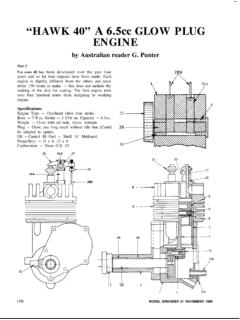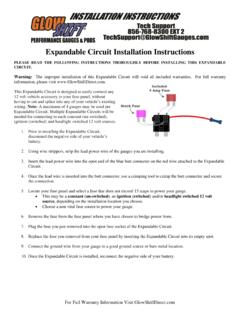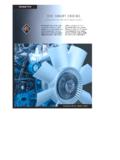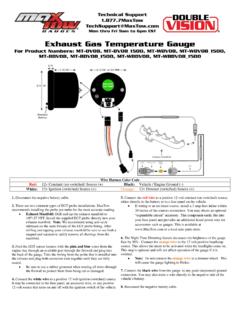Transcription of Ericc Whittle introduces his 10.6cc air cooled aero engine ...
1 Ericc Whittle introduces his air cooled aero engine with ~ glow plug ignition and commences construction with step-by-step details of the crank case..Part I Ericc Whittle , that's his hand, demon- strates his engine at the Old Warden Scale Weekend last summer. Onlookers were impressed by the ease with which the V88 started and the sweetness of its running. The 1995 Scale Weekend at Old Warden is scheduledd for 10-1 1 June. Introduction. V88 aero engines seem to have been a phenomenon of the early years of avia- tion. Examples, most of which seem to have been liquid cooled , were around before and during the first world war. There were some air cooled V8s- Renault and Curtiss were but two manu- facturers of the early years. Airdiscoo also made a 200 HPP air cooled V8, an exam- ple of which is to be seen in the DH 51 biplane in the Shuttleworth Collection at Old Warden.
2 This is the engine which our miniature most closely resembles. Miniature or working model air cooled V8ss also seem to be thin on the ground. The only model V8ss of which I know are liquid cooled automobile type engines in the larger scales, 1/5-1 small miniatures of either type of V88 seem not to have been contemplated by model engineers or other builders to date and it seemed to me that a really miniature V88 was just crying out to be made. I had already developed and built two very successful in-line 4- cylinder glow plug 4-stroke engines which had proved to be practical power units in a model aircraft, so why not use the same design in a V8 configuration? There was bound to be some slight power to weight advantage over the in- line 4-cylinder engines.
3 There would be one or two small problems to solve but nothing that could not be overcome. My engine took six months to make fromm start of construction to its first run on a 122 x 6in. propeller. It is an easy starter-it could hardly fail to be with all those cylinders! Maximum speed to date (approximately one hour's total running) is 7000rpmm with a 122 x 6in. propeller, idling speed is 2500rpm. This is when you realise you have a V8 for, at this speed, the engine is as smooth as silk and just purrs. For miniature engineering enthu- siasts, the dimensions are as fol- lows. Overall length is 4-1/2in.; width over exhaust pipes is 3-1/4in. and height is 3-1/88 inches. All-up weight is 15 ounces. The engine contains 550 components, over 280 of which are moving parts.
4 The equipment used to make the V88 was a Myfordd Super 7 with a VMA milling attachment, a 4in. rotary table and a set of 10mm Pultra collets in a home made collet spindle adapter. A bench drill, propane gas and the usual hand tools complete the list. Commercial items worked outt to be 8 glow plugs , 3 ball races and the 2 timing gears. At this point I must warn would-be builders that although the V8S is a straightforward engine to build and no special skills are required for any part of its construction, a huge amount of patience will be required to complete the engine to the running stage. It is most definitely not for the builder who is in any sort of a hurry. I shall assume that any reader who intends to have a go at the mini V88 will have sufficient machin- ing experience to build it from my draw- ings without too much interference from me.
5 Where appropriate, I shall describe the methods which I used for the various jobs and operations. This is not to say that my methods are either the best or the only ones, but they worked for me and will get the job done. Before we go any further, a list of materials required and their suppliers may be helpful. Crank case halves, front bearing hous- ing and rear gearbox housing 6in. x 2in. dia. HE30 aluminium alloy. Cylinders and crankshaft 18in. x lin. dia. EN 16T steel. Pistons and connecting rods 12in. x 1/2x 1 HE15 aluminium alloy. Cylinder heads 6in. x 1 in. dia. HE30. All the above materials are avail- able from Woking Precision Models, 100 New Street, Oundle. Peterborough PE8 4EA; tel: 0832-272868. Big end bearing shells, bronze shim available from Kirjeng Services, 17 Gables Lea, Sutton Bonnington, Leicestershire LE12 5NW; tel: 0509-672025.
6 Timing gears, 48DP, 1 x 18T. 1 x 36T steel spur gears, part numbers PG48-188 and PG48- 36, from Hinchliffe Precision Components Ltd., Storforth Lane Trading Estate, Chesterfield S41 0QZ; tel: 0246-209683. Crankshaft ball races, 3 x sealed ball races 13mm OD x 6mmm ID x 5mmm wide, will be obtainable from local bearingg stockist. 8 x ENYA 3 glow plugs will be needed when the engine is nearing completion. The rest of the material is various sizes of mild steel including 18in. of 1/4in. stainless steel, 6in. of 3/16in. OD copper tube and some 8, 100 and 12BA steel screws and nuts. all available from most model engineering suppliers and advertisers. Mostt of the screws and nuts used are non-standard, smaller heads on screws and nuts drilled and tapped the next even BA number size up.
7 This makes for a neatly fitted engine and is a must if you want to exhibit or demon- strate the engine on completion. The manufacture of suitable box spanners (nut spinners) will be dealt with later in the construction notes. Photographs will be used to show oper- ational set-ups where this is likely to be helpful but drawings will be used when the parts are too small to be photographed. Crankcase The 6in. chunk of 2in. dia. HE30 alloy will be ample to make the entire crankcase and front and rear bearing To start we need to saw or part off a piece 3in. long which will make both upper and lower case halves. Both ends should be faced smooth. Fit the 4- jaw chuck and face the piece to form a square bar 3 x 1-5/8 x 1-5/8inch.
8 The cor-ners will not clean up at these dimen- sions but this won't matter too much. What we should aim for is to get one corner with a 1/8in. wide unmachined section for the length of the work piece, then to equalise the three remaining unmachined widths to leave the work- piece nominally 1-5/8in. square. The cor- ner with the narrowest 1/8in. width will be the top of the crankcase. Now the cylinder mounting faces can be machined. These must, of course, finish up at to one other, easily achieved by flyy cutting. If the work is clamped to the boring table and truly aligned, can be removed 4766 MODEL ENGINEER 2 1 APRILL 1995 1:: Work on the crankcase is com- menced by flycut- ting a 3in.
9 Length of 2in. dia. HE30 light alloy to produce a bar 1-5 square. 2: Carefully marked out and set up, the camshaft bore is accurately posi- tioned with respect to the crakshaft position, centred, drilled and reamed to size. 3: Top and bottom halves of the crankcase are sepa- rated by the use of a slitting saw. The use of a Vee-block pro- vide good support to the embryo crankcase and feel- er gauges prevent the clamping force from closing the earlier sawcut. from one of the sides which forms the narrowest corner width. The work is then reclamped on the newly flyy cut surface, surface to boring table, and the other face fly cut. This will leave the unmachined corner width at about (see photo 1). These fly cut surfaces are the final finishes so take care of themm from now on.
10 While set up for tlycutting, the length of the work piece can be finalised by fly cutting both ends to the dimensions shown on the drawing. We now have two nice faces on which to mark out for the position of the crankshaft and camshaft centres. The crankshaft posi- tion must first be located and marked, easily done by scribing a line from and parallel to each of the cylinder mounting faces, as seen from the end of the workpiece. The distance from the crankshaft centre to the two cylinder mounting faces is inch. I used my scribing block on a surface plate and, with the aid of an eyeglass set the scriber point to above the surface plate against a steel rule. Put the work- piece on the plate. cylinder mounting face in contact with the plate.














